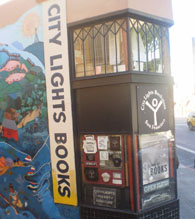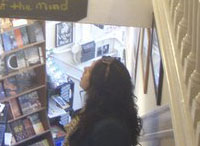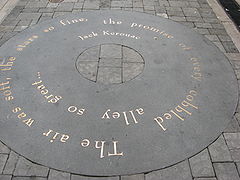A Visual-Spatial Approach to Spontaneous Composing in First-Year Composition
Marissa M. Juarez





Travelling Back: Movement as Spatial Praxis
I am always intrigued by the way bodies move through space. What do they see, feel, hear, smell, and do? How do they relate? How do they experience? How do they experience differently? Movement is a spatial practice, the passing of physical elements through space. And space, as Michel Foucault (1984) has argued, “is fundamental in any exercise of power” (p. 252). I am reminded of the mock border fence that was erected in the center of campus the same semester I took Professor Amy C. Kimme-Hea’s Spatial & Visual Rhetorics course, which initiated my thinking about this project. The installation was intended to bring attention to the lived realities of migrants who daily attempt to cross the border that sits just an hour’s drive south of our campus. Blisters. Sunburn. Dehydration. Rattlesnakes and scorpions. Hypothermia. Arrest and prosecution. Coercion by coyotes (human smugglers) who promise to show them the safest way north. Rape. Death by militants. Death by the elements. Death.
Before taking this class, I read scholarship by feminist critical geographers like Gillian Rose and Robyn Longhurst who argue that space itself operates in ways that display existing power dynamics within society. Space is indicative of social relations; social relationships are already spatial. The mock border fence reflects these relations of power within the space of the U.S./Mexico borderlands. While people in the U.S. worry about who’s coming into our country illegally and at what economic cost, people living in Mexico deal with economic hardship, loss of loved ones who leave them in search of opportunity, political conflict, and the devastation caused by a history of U.S. dominance. The border fence is a spatial construction that represents the materiality of migrants’ struggles. (Author’s Spatial & Visual Rhetorics in-class freewrite: 9-28-08)
Although the border wall, a 385-foot long construction that occupied the main thoroughfare of campus for one week, was meant to inspire empathy and awareness, it was viewed by many on campus as an inconvenience, a spatial impediment, a radically misguided statement on immigration policy. Yet it had profound rhetorical effects, inspiring debate, dialogue, and inquiry. At the very least, it fulfilled its purpose of making people experience an arbitrarily constructed border. Just like the borderline between the U.S. and Mexico, the mock border dictated where people could go and how they could move. It made manifest the spatial distribution of power between those living in the U.S. and those longing to live here, a division reified by the expressions of frustration felt by certain members of the campus community.
In Borderlands/La Frontera, Chicana feminist Gloria Anzaldúa (1999) posited that spatial histories can help us better to understand processes of marginalization and exclusion, interrupting hard-line divisions. For me, the simulated border made concrete such a history, revealing the strategies used to enforce dehumanizing border policies and ideologies. But, unfortunately, the presentation of that spatial history alone was not enough to evoke understanding from some. In Writing Women and Space: Colonial and Postcolonial Geographies, feminist geographers Alison Blunt and Gillian Rose (1994) contended that a politics of location that rejects the transparency so often used to delegate difference will help us write spatial histories that understand subjectivity as spatially and temporally contingent (see also Adrienne Rich, 1984). In conceptualizing the materials I wanted to present at the SVR2 Event, I kept coming back to the idea of borders, imagined and real. I envisioned a pedagogy that could help students uncover and articulate a politics of location that could help them identify intersections between race, class, gender, nationality, and religion. I wanted to encourage students to write the kind of spatial narratives that, according to Blunt and Rose (1994), could help them understand their own subjectivities as relational and as informed by the spaces and places they inhabit.
Additionally, my involvement in the University of Arizona Writing Program’s Difference and Inequality Committee, whose mission is to “promote faculty, staff, and student awareness of diversity issues, and the inequities that can come with diversity” (Hea et al, 2006), prompted me to begin thinking about classroom practices that could facilitate students’ and instructors’ thinking about space in ways that could bring further awareness to systems of inequality. What might these practices look like? How could I make them accessible for first-year composition instructors and students? How could I do so in a way that demonstrated value for students’ lived experiences and literacy practices?
I started thinking about authors I’d read who wrote about space in ways that inspired me. Jack Kerouac’s On the Road came to mind. I remembered a short piece of his I’d read years before, where he attempted to explain how he wrote. For whatever reason, Kerouac stirred my idea of having students practice writing their own spaces without focusing on form and style. Although I understand critiques that Kerouac’s writing is verbose and incoherent, I saw him as productive in terms of the kind of writing he produced. I came to see his style as an embodied method, relying on gut instinct and lived experience. I came to see spontaneous writing as a physical practice, imitating the deep, exhaustive breath of a jazz musician.
Yet when reflecting back on my choice to frame my project with Kerouac and his style of writing, I feel a slight uneasiness. I feel myself pushing back. In relying so heavily on Kerouac to structure my pedagogical materials, I became implicated in the (re)centering of Western white patriarchy. My project aspired to a feminist politics, but I failed to engage feminist scholarship in meaningful ways. And I failed to present a resistant reading of Kerouac’s position as a U.S. writer. The scholar I have become tells me I should have known better.
In the three years since I completed this project, I have continued to work at the intersections of bodies and movement, spatial interaction, and relational politics. The spatial theories my colleagues and I engaged in the SVR2 Event certainly help me understand these connections.